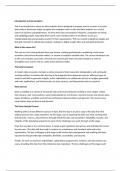Presentation
Data analysis
- Course
- Institution
Dive into the world of data-driven insights as we guide you through essential concepts, hands-on techniques, and real-world applications. Whether you're a beginner or looking to enhance your skills, this course covers everything from data collection and cleansing to advanced analytics and visualiza...
[Show more]



